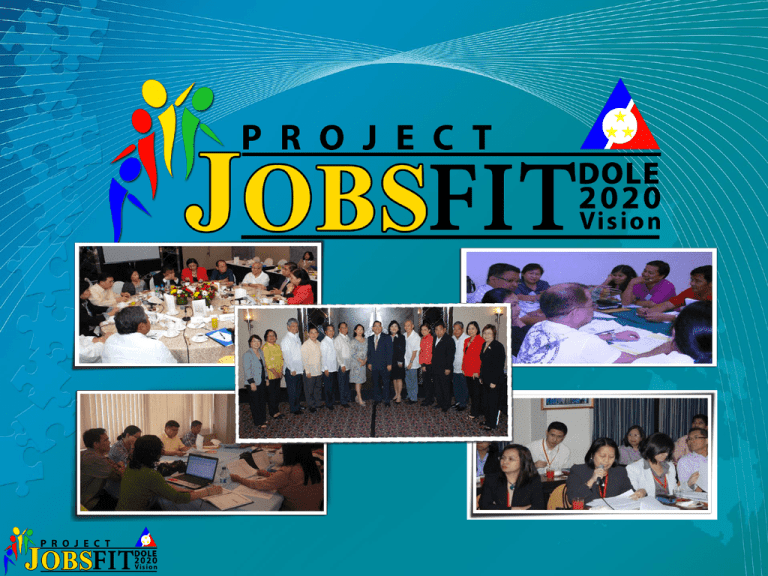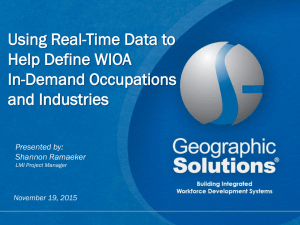2010 PRIORITY PROJECTS
advertisement

PROJECT JOBSFIT - Engages the stakeholders in a labor market signaling activity - Updates the labor market information of NMS (2006) and NHRC (2007) in aid of effective employment facilitation - Surfaces the labor market issues, and the corresponding recommendations to address the challenge of unemployment and talent mismatch OBJECTIVES 1. Identify the key employment drivers for the next ten years (2011-2020) 2. Assess the availability of the present and projected in-demand skills 3. Identify gaps and recommend strategies to address the gaps Working Groups • WG on Regional Stakeholders Consultation—BLE • WG on Labor Mobility and Employability Enhancement System—TESDA • WG on Consultation with Captains of Industry • WG on Overseas Employment Labor Market Intelligence (LMI) System—ILAB • WG on Overseas Employment Prospects— POEA Contents of report… • Summary of Results • Report on the Regional Consultations • Consulting the Captains of Industry • Availability of Skills • Overseas Employment Prospects • Summary of Issues and Recommendations • Annexes (Regional Labor Market Assessment) Industry Prospects Growth of Philippine economy will be driven by: 1. High-value, FDI-led agribusiness 2. Infrastructure (roads and highways, logistics, physical infrastructure projects) 3. Tourism (diving edge) 4. Medical Tourism 5. Retirement Estates (Subic, NCR, and cities of Tagaytay, Cebu , and Dumaguete) Industry Prospects 6. BPOs (35% annual growth, $13 billion in revenues by end of 2010) 7. Investment in ICT 8. Real estate (BPOs investing in office space, growth in domestic and international tourism); 9. Shipbuilding (exports of ships to the US, Mexico, and Norway); and 10.Long term demand for OFWs 12 KEGs that have potential for absorbing the most number of the Philippine workforce Key Employment Generators 1. 2. 3. 4. Agribusiness Cyberservices Health and Wellness Hotel, Restaurant and Tourism 5. Mining 6. Construction Key Employment Generators 7. Banking and Finance 8. Manufacturing 9. Ownership Dwellings and Real Estate 10.Transport and Logistics 11.Wholesale and Retail Trade 12.Overseas Employment Emerging Industries • Renewable Energy • Power and Utilities • Diversified Farming and Fishing • Creative Industries Hard-to-fill and In-demand Occupations • There were about 108 identified hard-to-fill and in-demand occupations in the KEGs • The data were cross-checked with the following reports: – results of the DOLE-led survey on Occupational Shortages and Surpluses (BLES) – Output of the Presidential Task Force on Education Excerpt from the main report… Agribusiness Hard-to-Fill Occupation Aqua-culturist Occupational Title Aquaculture Farm Caretaker Aquaculture Farm Aide Fish Nursery Worker Prawn Farm Cultivator Competency Standard Aquaculture NCII Availability of Skills • Manpower stock shows that the 4 most popular degree programs are Nursing, Information Technology, Teacher Education, and Hotel and Restaurant Management • On TVET, around 693,143 certified workers out of the total certified 885,647 workers from 2006-2008 are into skills under the identified priority sectors Issues/Gaps • Lack of experienced and highly skilled workers • School curriculum not responsive to industry needs • Poor dissemination of Labor Market Information (LMI) Recommendations • Make OJT relevant to student’s field of work. (Review of apprenticeship and learnership policy) • Strengthen industry-academe linkage to improve the employability of workers • Establish government agency that is mandated to handle HRD concerns Recommendations • Refocus agricultural courses and review their standards • Intensify career guidance and dissemination of labor market information on in-demand occupations, especially for high school students • Improve language/English competency Recommendations • Establish/convene industry councils for regular labor market signaling activity • Build a national qualification system that is aligned with the international standards • Make the best talents stay in the country Recommendations • Create employment opportunities for nurses to address oversupply • Develop and strengthen emerging industries and harness OFW remittances for investments that create employment • Re-assess and review the Labor Code, as well as existing work-related laws and policies End of Presentation Visit our websites: www.ble.dole.gov.ph www.phil-job.net











